Mastering the dotted 8th note is essential for creating syncopated rhythms. A dotted eighth note is worth 1.5 beats in a 4/4 time signature. Start by recognizing its appearance: an eighth note followed by a dot. Use exercises like clapping the rhythm and practicing with a metronome to build familiarity. Try tapping your tempo to internalize the rhythm, and calculate delay settings by dividing 45 by your song’s BPM. Emphasize every third sixteenth note to bring out the groove. Consistent practice helps you nail these rhythms, revealing more expressive musical phrasing. Here’s how you can take your skills further!
Key Takeaways
- Recognize dotted eighth notes by their appearance: an eighth note with a dot, adding half its value.
- Calculate delay settings for dotted 8th notes by dividing 45 by the song’s BPM for rhythmic accuracy.
- Practice clapping and tapping rhythms with a metronome to internalize the timing of dotted eighth notes.
- Emphasize every third sixteenth note within the beat to enhance groove and rhythmic feel.
- Regularly practice with accent patterns and creative phrasing to develop expressive dotted 8th note rhythms.
Understanding Dotted 8th Notes
Dotted eighth notes might seem challenging at first, but once you understand their timing and placement, they’ll add an engaging groove to your music. These notes have a value of 3/16 or 1.5 beats in a 4/4 time signature, making them vital for creating syncopated rhythms. Syncopation, where the emphasis is on the off-beats, brings a fresh and exciting dynamic to your rhythmic patterns, enhancing your musicality.
To comprehend dotted eighth notes, think of them as ‘1-and-a’ in relation to the beat. This counting method helps you internalize their timing, especially important when shifting between different rhythmic values. In compound time signatures like 6/8, a dotted eighth note equals one beat, simplifying the timing a bit.
For mastering these notes, practice exercises are essential. Start by clapping the rhythm while counting ‘1-and-a’ to get the feel. Gradually incorporate these rhythms into your instrument practice, using metronomes to keep your timing precise.
Performance techniques also play a role here. Emphasize the dotted eighth notes to highlight their syncopation, giving your music that extra groove. With consistent practice, you’ll find these notes enhancing your overall musicality and rhythmic versatility.
Visual Representation
When reading sheet music, you’ll recognize a dotted eighth note by its distinct appearance: an eighth note with a dot placed directly after it. This visual representation is essential for understanding its extended duration. The dot adds half the value of the eighth note, making it equivalent to three sixteenth notes.
To help you grasp the concept more effectively, let’s break it down:
- Recognizing Duration: The dotted eighth note lasts for one and a half times the length of a standard eighth note. This means you’ll hold the note for the equivalent of three sixteenth notes. Visualizing this can make it easier to count and play accurately.
- Rhythmic Interpretation: Dotted eighth notes often appear in syncopated rhythms. They add complexity and groove to the music, requiring precise timing. When you see a dotted eighth note, remember it’s not just a quick beat but a slightly elongated one that adds character to the rhythm.
- Practical Examples: Practice identifying and playing dotted eighth notes in simple melodies. Look for them in pieces like Beethoven’s ‘Für Elise’ or modern jazz compositions. This hands-on approach reinforces your ability to recognize and interpret them correctly on sight.
Importance in Music
Understanding how to recognize and read dotted eighth notes sets the stage for appreciating their important role in shaping the rhythm and feel of various musical genres. These notes are vital for creating syncopated rhythms that can bring a unique groove to your music. You’ll find them across rock, pop, jazz, and classical compositions, proving their versatility and universal appeal.
Mastering dotted eighth notes can greatly enhance your rhythmic skills and musical expression. By incorporating them into your playing, you’re opening doors to greater musical creativity. Dotted eighth notes allow you to play around with the timing and syncopation, adding unexpected twists that can make your music more engaging and dynamic.
Utilizing dotted eighth notes effectively can bring a new level of performance dynamics to your compositions. They add complexity and flair, making your pieces stand out. Proper execution is important, as it helps maintain a steady tempo while adding these rhythmic flourishes.
When you nail the dotted eighth note, you’re not just keeping time; you’re adding character and depth to your music, making it more compelling for your audience.
Calculating Delay Settings
To master the dotted 8th note effect, you’ll need to calculate the right delay settings by dividing 45 by your song’s BPM to get the delay time in milliseconds.
For example, at 120 BPM, this would be 375 milliseconds.
Make sure to set your delay’s feedback to zero and match the delayed notes’ volume to the original for a seamless rhythm.
Delay Time Formula
Calculating the delay time for dotted 8th notes involves a simple yet significant formula: divide 45 by your song’s BPM to get the delay setting in milliseconds. This formula is vital for mastering the delay technique and achieving rhythmic accuracy in your music. By calculating the correct delay setting, you can synchronize the tempo of your song with the delay effect, guaranteeing musical precision.
To get started, follow these steps:
- Determine the BPM: First, find out the tempo of your song in beats per minute (BPM). This tempo synchronization is pivotal for setting the delay time accurately.
- Apply the Formula: Divide 45 by the BPM. For example, if your song is at 120 BPM, the calculation would be 45/120, which equals 0.375 seconds or 375 milliseconds. This gives you the exact delay setting for dotted 8th notes.
- Adjust Your Delay Pedal: Set your delay pedal to the calculated milliseconds. This ensures that the dotted 8th notes are accurately represented in the echo effect, creating a cohesive and rhythmic sound.
Utilizing this method allows you to achieve the desired rhythmic effect and enhances your overall performance. Accurate delay settings are key to mastering the dotted 8th note technique.
Setting Accurate Tempo
After determining the correct delay time, the next step is to validate your tempo settings are accurate for the best rhythmic effect. Begin by integrating metronome practice into your routine. A metronome is an essential tool for maintaining tempo accuracy, ensuring your playing aligns perfectly with the calculated delay settings.
For instance, at 120 BPM, your delay should be set to 375 milliseconds.
Incorporate music theory to understand how delay techniques enhance your sound. Setting the repeat/feedback on your delay to zero will help you focus on timing without additional repetitions muddying the rhythm. Adjust the volume of the delayed notes to match the original notes, creating a seamless and cohesive effect.
Next, synchronize your playing with the delay time. This step is pivotal; without proper synchronization, even the most accurate calculations won’t achieve the desired rhythmic pattern. Practicing with a metronome helps you develop a keen sense of timing, making it easier to lock in with the delay.
Tapping Tempo
Synchronizing your taps with the beat of the music is essential for mastering the rhythm and timing of dotted eighth notes. By accurately tapping the tempo, you not only set the pace but also guarantee consistent timing throughout your performance. This practice can greatly enhance your tempo accuracy and lead to notable rhythmic improvement.
To get started, you can use various tools and techniques to tap the tempo:
- Manual Tapping: Use your foot or hand to tap along with the beat. This helps develop an internal sense of timing.
- Metronome Usage: A metronome is invaluable for maintaining steady musical timing. Set it to a comfortable tempo and tap along, focusing on aligning your taps with the clicks.
- Tap Tempo Pedals: These electronic devices allow you to tap a tempo, which then sets a consistent beat for you to follow. They’re particularly useful in live performances.
Consistent practice with these methods will embed a strong sense of timing in your playing. Regularly tapping the tempo helps you internalize the rhythm, making it easier to execute dotted eighth notes with precision. This dedication to tempo accuracy and rhythmic enhancement will boost your overall musical performance.
Accenting Beats
Once you’ve nailed down the tempo, the next step is to master accenting beats within the dotted eighth notes to bring your music to life. Accenting beats involves emphasizing every third sixteenth note within the beat, creating distinct rhythmic accents that enhance the groove and feel of your music. When you place accents on the first and third notes of the dotted eighth note, you add a layer of musical dynamics that can transform a simple rhythm into something much more engaging.
Accents placed on the off-beats can create syncopated rhythms, driving the momentum of your music and keeping listeners hooked. As you experiment with different accent patterns, you’ll discover the potential for creative phrasing that can make your compositions stand out. Here’s a visual representation to help you imagine the impact of accenting beats:
| Beat Position | Accented Notes | Resulting Feel |
|---|---|---|
| 1st and 3rd | Yes | Strong, driving rhythm |
| 2nd and 4th | No | Less emphasis, smoother flow |
| Off-beats | Yes | Syncopated, dynamic movement |
Practical Tips
To truly master the dotted eighth note, start by incorporating consistent practice routines that include metronome work and accent experimentation. By doing so, you’ll develop both precision and creative flair in your musical interpretation.
Here are some practical tips to help you on this journey:
- Use a Metronome: Practicing with a metronome is crucial for maintaining a steady tempo. Tap quarter notes to internalize the rhythm of dotted eighth notes. This will help you lock in the timing and guarantee your notes are consistently placed.
- Experiment with Accents: Add variety to your practice by accenting different subdivisions. This enhances your rhythmic feel and enriches your performance techniques. Try emphasizing the first, third, and fifth subdivisions within a measure to see how it changes the musical texture.
- Employ a Footswitch for Tap Tempo: A footswitch can be highly beneficial for on-the-fly adjustments. This allows you to match delay patterns to the desired dotted eighth note value seamlessly, giving your performances a cohesive sound.
Echo Technique Examples
When you’re prepared to explore the echo method, look to guitar legends like Yngwie Malmsteen, Van Halen, and Paul Gilbert for stellar examples. These masters have seamlessly integrated this method into their playing, making their solos iconic.
Yngwie Malmsteen is renowned for his virtuoso techniques. His use of the echo effect is meticulous, often employing a delay pedal to create rhythmic patterns that add a rich, layered texture to his solos. By synchronizing his notes with the delay time, he achieves a cascading sound that enhances his rapid arpeggios and intricate runs.
On the other hand, Van Halen’s legendary solos demonstrate another dimension of the echo method. Eddie Van Halen’s innovative use of delay pedals allowed him to produce a rhythmic echo that gave his solos a unique, almost otherworldly feel. His ability to sync his playing with the delay created a dynamic and fluid sound that became a signature in his performances.
Paul Gilbert also excels with the echo method, using it to add depth and complexity to his compositions. His precision in timing ensures that each echoed note complements the main melody, resulting in a harmonious and fuller sound.
Application in Solos
When you incorporate dotted 8th notes into your solos, you add rhythmic diversity that captures the listener’s attention.
Focus on timing and precision to guarantee each note lands perfectly, creating compelling rhythmic variations.
Experiment with expressive phrasing by accenting and resolving these notes to enhance your solo’s dynamics and engagement.
Timing and Precision
Mastering the timing and precision of dotted 8th notes in your solos can transform your playing, adding a layer of rhythmic complexity that engages your listeners. By focusing on rhythmic nuances and musical precision, you’ll enhance your solos to new levels. Here’s how you can achieve this:
- Use a Metronome: Practicing with a metronome is crucial for timing mastery. It helps you maintain a steady tempo, ensuring that your dotted 8th notes are perfectly placed within the beat. Start slow, gradually increasing the tempo as you become more comfortable.
- Accents and Articulations: Experimenting with different accents and articulations can add depth and expression to your playing. By emphasizing certain notes or adding staccato and legato touches, you can create engaging and dynamic musical phrases that showcase your control over rhythmic complexity.
- Focus on Timing Variations: Incorporating timing variations in your solos can make your playing more captivating. Practice shifting the placement of your dotted 8th notes within the measure to discover unique rhythmic patterns. This won’t only improve your timing but also enhance the overall musicality and impact of your solos.
Rhythmic Variations
Exploring rhythmic variations with dotted 8th notes in your solos can breathe new life into your music, adding an interesting layer of complexity that keeps your audience engrossed. By incorporating dotted 8th notes, you can create syncopated rhythms that enhance the dynamics of your solos, making each performance more enthralling.
One of the creative applications of dotted 8th notes is experimenting with different accents and note placements. This can lead to unique rhythmic patterns that stand out. For instance, placing the accent on the second or third dotted 8th note in a sequence can dramatically change the feel of your solo.
| Technique | Description |
|---|---|
| Accenting | Emphasize specific dotted 8th notes |
| Syncopation | Offset rhythm creating unexpected beats |
| Note Placement | Changing the position of dotted 8th notes |
| Dynamic Shifts | Varying volume and intensity within phrases |
To delve into more advanced techniques, try combining dotted 8th notes with other note values, creating intricate rhythmic tapestries. This not only makes your solos more fluid but also keeps the listener intrigued.
Incorporating these rhythmic variations isn’t just about playing the notes; it’s about weaving them into your solos to create a fluid and engaging melodic journey. Experimenting with these techniques will open up new avenues for expression, ultimately refining your musical voice.
Expressive Phrasing
Harnessing the power of dotted 8th notes in your solos can transform a standard phrase into an emotionally charged and engrossing musical statement. By accenting notes on the offbeat, you can create a unique rhythm that stands out, adding both complexity and flair to your playing.
To truly capture the emotional depth of your solos, it’s essential to experiment with varying dynamics and articulation.
Here are three key strategies to enhance your soloing using dotted 8th notes:
- Accenting Notes: Place emphasis on offbeat notes to create syncopation, making your solo more engaging and rhythmically interesting.
- Adding Texture: Incorporate techniques like slides, bends, and vibrato to give your phrases more character and expressiveness.
- Exploring Scales and Modes: Use different scales and modes to add melodic variety, ensuring that your dotted 8th note passages are both harmonically rich and versatile.
Paying close attention to timing and placement will guarantee your dotted 8th notes fit cohesively within your solos. With practice, you can seamlessly integrate these techniques, making your playing not just technically proficient but also deeply expressive. This approach will captivate your audience and bring a new level of sophistication to your guitar solos.
Frequently Asked Questions
How Do You Teach Dotted Eighth Notes?
You teach dotted eighth notes by using effective teaching strategies, including rhythmic exercises and clear notation interpretation. Incorporate practice techniques like counting out loud, clapping, and playing with a metronome to guarantee accurate timing and internalization.
How to Tap Dotted 8th?
To tap dotted 8th notes, use a 3:2 rhythmic pattern against the song’s tempo. Practice techniques include using a metronome, maintaining tempo control, and focusing on musicality interpretation to guarantee accurate and engaging rhythms.
How Long Does It Take to Hold a Dotted Eighth Note?
To hold a dotted eighth note, you need proper timing and demonstration. A common mistake is rushing the note. Practice techniques like counting “1-e-and” help maintain accuracy, ensuring you hold it for 3/4 of a beat.
How to Play Dotted Eighth Notes on Guitar?
To play dotted eighth notes on guitar, focus on finger positioning and speed control. Practice subdividing beats into sixteenth notes with a metronome. Experiment with strumming patterns and listen to songs featuring dotted eighth notes.
Conclusion
Mastering the dotted 8th note opens up a world of rhythmic complexity and musical expression. By understanding its structure, visualizing its placement, and calculating the right delay settings, you can enhance your playing.
Tapping tempo and accenting beats will add precision, while practical tips and echo techniques offer creative freedom. Apply these skills in your solos, and you’ll see a significant improvement.
Keep practicing, and you’ll make the dotted 8th note an integral part of your musical toolkit.




